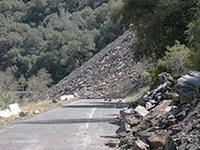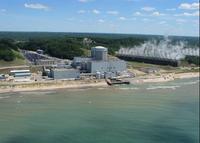-
“Dirty blizzard” accounts for missing Deepwater Horizon oil
The Deepwater Horizon disaster spilled more than 200 million gallons of oil into the Gulf of Mexico. Microbes likely processed most of the oil within months of the spill, but these microbes do not account for all of the spilled oil. Scientists have now found what happened to the oil not processed by microbes: the oil acted as a catalyst for plankton and other surface materials to clump together and fall to the sea floor in a massive sedimentation event that researchers are calling a “dirty blizzard.” The oily sediments deposited on the sea floor could cause significant damage to ecosystems and may affect commercial fisheries in the future.
-
-
2012 economic losses from disasters set new record at $138 billion
The UN Office for Disaster Risk Reduction (UNISDR) reported that for the first time in history, the world has experienced three consecutive years in which annual economic losses have exceeded $100 billion. The losses are the result of an enormous increase in exposure of industrial assets and private property to extreme disaster events.
-
-
Building stronger, greener concrete with biofuel byproducts
The world uses nearly seven billion cubic meters of concrete a year, making concrete the most-used industrial material after water. Even though making concrete is less energy intensive than making steel or other building materials, we use so much of it that concrete production accounts for between 3 to 8 percent of global carbon dioxide emissions.
-
-
New structure for regulation of geoengineering research needed: experts
Geoengineering, the use of human technologies to alter the Earth’s climate system — such as injecting reflective particles into the upper atmosphere to scatter incoming sunlight back to space — has emerged as a potentially promising way to mitigate the impacts of climate change. Such efforts, however, could present unforeseen new risks. This inherent tension has thwarted both scientific advances and the development of an international framework for regulating and guiding geoengineering research.
-
-
Predicting landslides

A landslide can seriously injure or even kill people. Now, a new early warning system will be the first to employ geological data in tandem with the latest weather forecasts to provide a concrete warning in emergency situations.
-
-
Obama: at least some Chinese cyberattacks on U.S. are “state sponsored”
In an interview to be aired today on ABC News, President Barack Obama said that some, but not necessarily all, cyberattacks on U.S. firms and infrastructure originating in China were “state sponsored.” Obama stressed the need to avoid “war rhetoric” when discussing cyberattacks, and renewed his calls for Congress to strengthen cyber security while protecting civil liberties.
-
-
Urgent need to find asteroids that threaten Earth: expert
The impact from a 100-meter long asteroid hitting Earth would be equal to detonating a 100-megaton hydrogen bomb. Several large asteroids have zipped dangerously close to Earth in the past month. There are millions of these near-Earth-orbit (NEOs) asteroids longer than 100 meters. Because they are relatively small, and because they spend so much time far from Earth, scientists tend to find them only by chance.
-
-
Russia embarking on a program to thwart asteroid threat
Officials from Rosatom, Russia’s nuclear agency, and from Russia’s space agency, yesterday (Tuesday) told a special conference at the Russian Federation Council, the Russian upper house, that Russia was embarking on an ambitious program – estimated to cost about $2 billion – to shield Russia from the threat of asteroids and meteors. The first steps will be taken by the end of the year, but the comprehensive set of measures will not be available until 2018-20. The officials discussed various possible measures, ranging from planting beacon transmitters on asteroids to megaton-sized nuclear strikes to destroy asteroid or divert them from a course which would lead to a collision with the Earth.
-
-
Ohio’s Perry nuclear power plant was vulnerable to sabotage
A report issued last week said that operators at the Perry Nuclear Power Plant in Ohio found a vulnerability in the security of the plant last year, and that that vulnerability could have put the public in harm’s way. The utility operating the nuclear plant reported to the Nuclear Regulatory Commission (NRC) that the plant’s security program for monitoring underground pathways and other unattended openings were insufficient to detect and prevent unauthorized access to the protected area.
-
-
CAST’s webinar on perimeter lighting
The CAST LED Perimeter Lighting System has won many awards and recognitions in the lighting and security industries in 2012. On 20 and 21 March, it offers an “In-Depth Perimeter Lighting Webinar.”
-
-
Missouri looking for ways to fund infrastructure repairs
As is the case in other states, Missouri faces “a huge backlog of repair and maintenance needs” in its infrastructure, in the words of a state lawmaker. Lawmakers debate bond issue, increase in state sales tax, and other measures to fund the necessary repairs.
-
-
Michigan’s Palisades nuclear power plant has significant safety issues

A recent report by the Union of Concerned Scientists (UCS) lists the Palisades Nuclear Power Plant in Michigan as one of three plants in the United States with significant safety episodes or “near-misses” over the last three years.
-
-
Making future sea-level predictions more accurate
Sea-level rise is a major issue facing those in charge of infrastructure protection in coastal communities. New research into radiocarbon dates of tiny fossilized marine animals found in Antarctica’s seabed sediments offers new clues about the recent rapid ice loss from the West Antarctic Ice Sheet and helps scientists make better predictions about future sea-level rise.
-
-
Grid-scale batteries for storing renewable energy have large carbon footprint
Most of the electricity produced in the United States comes from coal- and natural gas-fired power plants. Only about 3 percent is generated from wind, solar, hydroelectric, and other renewable sources. A key problem is that the U.S. electrical grid has virtually no storage capacity, so grid operators cannot stockpile surplus clean energy and deliver it at night, or when the wind is not blowing. Stanford scientists have developed a novel way to calculate the energetic cost of building large batteries and other storage technologies for the electrical grid. The found that the fossil fuel required to build these technologies could negate some of the environmental benefits of installing new solar and wind farms.
-
-
Napolitano testifies on cybersecurity executive order
Two Senate panels questioned DHS Secretary Janet Napolitano yesterday at a hearing on President Obama’s cybersecurity executive order and what issues need to be addressed in cyber legislation. “We simply cannot afford to wait any longer to adequately protect ourselves,” Said Senator Jay Rockefeller (D-West Virginia), chairman of the Senate Commerce Committee.
-
More headlines
The long view
Helping Strengthen America’s Critical Infrastructure
Everyday life depends on a robust infrastructure network that provides access to running water, communications technology and electricity, among other basic necessities. The experts who keep our national infrastructure secure and resilient also need a strong network to share their knowledge and train the next generation of professionals capable of solving complex infrastructure challenges.
AI and the Future of the U.S. Electric Grid
Despite its age, the U.S. electric grid remains one of the great workhorses of modern life. Whether it can maintain that performance over the next few years may determine how well the U.S. competes in an AI-driven world.
Using Liquid Air for Grid-Scale Energy Storage
New research finds liquid air energy storage could be the lowest-cost option for ensuring a continuous power supply on a future grid dominated by carbon-free but intermittent sources of electricity.
Enhanced Geothermal Systems: A Promising Source of Round-the-Clock Energy
With its capacity to provide 24/7 power, many are warming up to the prospect of geothermal energy. Scientists are currently working to advance human-made reservoirs in Earth’s deep subsurface to stimulate the activity that exists within natural geothermal systems.
Experts Discuss Geothermal Potential
Geothermal energy harnesses the heat from within Earth—the term comes from the Greek words geo (earth) and therme (heat). It is an energy source that has the potential to power all our energy needs for billions of years.
